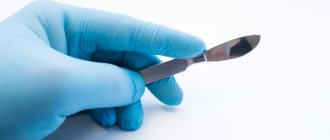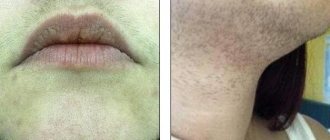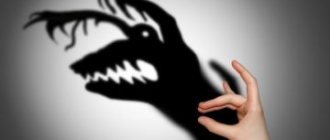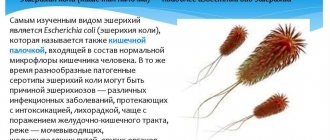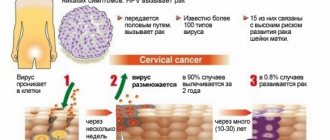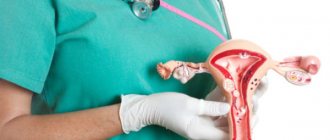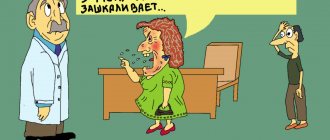Hernias of the anterior abdominal wall, internal diaphragmatic hernias or hernias of the posterior abdominal wall make up the majority of all surgical interventions on the human body. A strangulated inguinal hernia is a serious pathology, the development of which is a direct indication for emergency surgical intervention.
Bilateral inguinal hernia
Causes
Inguinal hernias are usually divided into acquired and congenital. Congenital inguinal hernia is diagnosed in 90% of cases in young children. The remaining 10% are detected in adults. The causes of this type of pathology are associated with disorders that occur during intrauterine development of the fetus. Basically, a congenital inguinal hernia is diagnosed in a baby immediately after birth and it progresses over time. Sometimes the disease accompanies other defects.
Among all inguinal hernias, 85% are acquired. Their causes are usually divided into producing and predisposing.
Predisposing ones include:
- Hereditary predisposition to this pathology.
- Age. With age, the likelihood of its occurrence increases.
- Features of a man's physique.
- Weight and its stability. It is noted that with sudden weight loss, the risk of pathology increases significantly.
- Paralysis of the nerves that control the muscles of the peritoneal wall.
Among the producing causes are those that contribute to an increase in pressure inside the abdominal cavity:
- Frequent constipation.
- Active sports.
- Jumping from heights.
- Hard physical labor.
- Prolonged standing.
Surgeon Viktor Vladimirovich Zhdanovsky will talk about the causes of hernias in men, 70% of which are inguinal:
- Frequent cough.
- Blows to the abdominal area.
- Ascites.
- Difficulty urinating.
- Age-related changes in muscle tissue.
Can the disease go away on its own?
The answer to this question is unequivocal - no, it cannot. To understand this, you need to understand the reasons that cause an inguinal hernia.
Only 3% of men have a congenital hernia, which is the result of intrauterine development disorders and congenital weakness of the abdominal muscles of the inguinal ring.
Such a long absence of treatment is possible only in one case - if the hernia was very small in size and did not increase as the body grew.
In most cases, hernias are acquired. The reasons for the appearance of pathologies of this kind are:
- weakness of the muscle corset and connective tissue of the groin organs;
- excessive physical activity, accompanied by a constant increase in intra-abdominal pressure.
Varieties
Inguinal hernia in men is divided into the following types:
- A direct inguinal hernia occurs as a result of weakening of one of the walls of the inguinal canal. A prerequisite for a direct inguinal hernia to occur is age-related changes in men.
- An indirect inguinal hernia runs obliquely relative to the inguinal canal and protrudes through the opening in it. It is capable of descending into the scrotum area. This pathology is called testicular hernia in men. It is noted that the indirect inguinal hernia is located exclusively on one side.
- A sliding inguinal hernia is diagnosed when the wall of the hernial sac becomes the cecum, bladder or other organ that is not completely covered by the peritoneum.
The cause of these types of hernias is muscle weakness of the wall of the canal in the groin. It is impossible to get rid of the pathology using conservative methods. This requires an operation during which the posterior wall of the canal is strengthened.
There is also an inguinal-scrotal hernia in men, which is the release of internal organs into the scrotal area due to the weakness of the connective tissue of the inguinal ring. It can arise for various reasons. If we talk about children, then heredity or congenital factors are paramount for them. For adults, acquired causes of inguinal hernia are more common.
In addition, internal or canal hernias in the groin that do not extend beyond the inguinal ring are diagnosed. But when coughing or excessive tension of the abdominal muscles, a bulge is visible under the skin.
There are also these types of inguinal hernias: reducible and non-reducible. The difference between the reducible one is that while in a lying position, the doctor or even the patient is able to independently adjust the bag into the abdominal area.
Depending on which side of the inguinal ring the pathology arose, there is the following classification:
- Left-sided inguinal hernia.
- Right-sided inguinal hernia.
- Bilateral hernia in the groin.
Types of inguinal hernias, structural features
The hernial sac has a body, neck, bottom and mouth. It is filled with intra-abdominal organs, for example: part of the small intestine, sigmoid, appendix, greater omentum or other formations.
In this case, the inguinal canal is a hernial orifice, i.e. through it protrusion of organs occurs, which normally should not leave the abdominal cavity.
In men, an inguinal hernia is much more common - this is due to anatomy - the canal between the broad muscles of the abdomen in women has a narrower and elongated structure, as well as a stronger structure.
Inguinal hernias come in several varieties and are classified according to several different criteria. According to the anatomical features, hernias can be oblique and straight, sometimes they can also be combined.
There are 4 stages of development of an inguinal hernia:
- At the first stage, the protrusion is palpable with a strong cough or abdominal tension.
- The second stage, characterized by canal protrusion of the inguinal slits.
- At stage 3, an oblique hernia is formed along the canal.
- At stage 4, the contents of the hernia descend into the scrotum.
By origin, congenital and acquired inguinal hernia are divided.
Most often, an indirect hernia is one-sided and appears in men only at a young and slightly older age. In this case, the hernia gate has an oblique direction only at the beginning of the development of the disease. Over time, the hole in the muscle widens to the side.
An indirect hernia can be congenital. Formed when the testicle descends into the musculocutaneous funnel.
If the testicle does not reach the bottom of the scrotum in time, and an unclosed exit remains behind it, then the formation of a congenital inguinal hernia of an oblique type occurs. In this case, parts of organs can penetrate into the passage that is not closed.
A direct hernia is only acquired. It is caused by the influence of provoking (promoting) factors on the body. They are associated with increased pressure inside the abdominal cavity. The hernial sac is localized near the gap in the groin, without touching the spermatic cord.
Inguinal hernia in men photo and location
With a combined inguinal hernia, hernial sacs of various locations and shapes are found. They can be multiple.
Inguinal hernia also varies in location. In men, it can have bilateral localization. This means that it is characterized by the same size on both sides of the scrotal or groin area.
The left-sided localization of the hernia is formed due to the peculiarities of the anatomical structure of this area. They predispose to a more frequent occurrence of hernias on the left.
With right-sided localization, the pathological process is a consequence of an imbalance in the intra-abdominal pressure exerted and the reserve that the peritoneum can withstand without leading to organ prolapse.
Symptoms
Signs of the disease may appear in the patient during infancy or occur throughout life. In this case, the primary signs will always be the same.
In most cases, a man himself can recognize a characteristic protrusion. It can increase in size in case of coughing or physical activity. The bulge is soft and elastic to the touch. There are no unpleasant sensations during palpation.
While in a standing position, the hernia in the groin increases, and in a lying position it decreases accordingly. If you gently press on it, a characteristic rumbling sound appears, and the formation itself is reduced without problems, after which you can palpate the wide opening of the inguinal ring. If a man has an inguinal-scrotal hernia, after reduction it will be asymmetrical.
The hernia can become inflamed and strangulated. Sometimes the pathology leads to inflammation of the testicles (orchitis) or intestinal obstruction. A strangulated inguinal hernia requires immediate medical attention. This condition can be recognized by:
- Sharp pain in the groin.
- Nausea.
Surgeon, Doctor of Medical Sciences Viktor Nikolaevich Kosovan answers questions about the symptoms of the disease:
- Inability to reduce the protrusion.
- Inability to have a bowel movement.
- The presence of blood in the stool.
Causes of inguinal hernias
There are a number of reasons that can lead to the formation of a hernia in the groin. They are usually divided into two groups - predisposing factors (there is an increased risk of developing a hernia) and provoking factors (contribute to the development of the disease if there is a predisposition).
The first include (associated with increased intra-abdominal pressure):
- Hard physical work.
- Persistent cough.
- Dysfunction of the gastrointestinal tract.
- Anomalies in the structure of the posterior wall of the groin canal.
- Urinary retention.
The second include:
- Anomalies in the structure of the posterior wall of the groin canal.
- Abdominal injuries.
- Weak abdominal muscles.
- Prostate pathologies.
People whose relatives have had an inguinal hernia face an increased risk. Certain medical conditions, such as cystic fibrosis. Against the background of frequent, unproductive cough, pressure from organs localized in the abdominal cavity increases.
Severe or moderate obesity, leading to increased pressure in the abdominal cavity.
An inguinal hernia can be an occupational disease when work is associated with a constant static state or heavy physical activity.
Premature children in adulthood are more likely to develop a pathology such as inguinal scrotal hernia in men. This is due to the incomplete formation of the peritoneum until 37 weeks. As a result, it has reduced resistance, predisposing to the occurrence of a hernia.
Surgical treatment performed for a unilateral hernia in the groin does not exclude the possibility of its occurrence on the other side. Therefore, operated patients should adhere to specific recommendations.
Diagnostics
In any case, the diagnosis of an inguinal hernia begins with a detailed examination of the patient in different positions (standing, lying, in a state of tension). After this, the doctor will perform palpation and the possibility of reduction.
Further instrumental diagnostic methods are used:
- X-ray with a contrast agent, which is introduced into the abdominal cavity by puncturing it.
- Ultrasound.
How is a prostate ultrasound performed? Read the detailed article.
The photo shows an ultrasound procedure of the groin area
Differential diagnosis allows us to exclude pathologies such as a hernia on the testicles in men, inflammation of the appendage, vascular aneurysm, cryptorchidism, lipoma, hydrocele of the testicles, torsion of the spermatic cord, femoral hernia or inflammation of the lymph nodes in the groin area.
Which doctor do patients with suspected pathology go to? A surgeon can identify an inguinal hernia and prescribe the necessary therapy.
First signs
Signs may have varying intensity depending on the size of the protrusion initially:
- pain localized in the protrusion area and spreading to the lower abdomen and groin;
- attacks of nausea and vomiting;
- constipation
Signs such as nausea and vomiting do not always appear during strangulation. The presence of these symptoms depends on which organs are trapped in the hernial sac. There will be no nausea if the spermatic cord is pinched in boys. If the abdominal organs are pinched, nausea will indicate the presence of dysfunction of the digestive system.
If the hernial formation in the groin has reached a large size, the signs of strangulation will be pronounced.
The pain is severe and intensifies upon contact with the hernia. There is vomiting, intestinal motility is disrupted, the abdomen increases in size, becomes hard, and severe flatulence is present.
The child cannot go to the toilet; fecal retention causes intoxication of the body. The general condition worsens, the body temperature rapidly rises. The skin at the site of the hernial protrusion acquires a bluish tint or turns red.
An increase in hernia strangulation can cause an increase in body temperature.
Treatment
Knowing the signs of an inguinal hernia in men, the doctor will make a diagnosis and prescribe treatment, which includes surgery. If it is not restrained, then surgical intervention is not an emergency and is planned in advance.
What does an andrologist do? We figure out what a male doctor treats.
The use of traditional conservative methods of therapy, wearing a bandage or corset, and treating an inguinal hernia with folk remedies, unfortunately, cannot completely rid the patient of this pathology. This is due to the peculiarities of male anatomy. The disease can only be cured by surgery, the main task of which is to return the contents of the hernial sac to its natural position in order to avoid relapse.
There are 2 types of surgery:
- Complete removal with suturing of the hole in the groin.
- Removing the sac and strengthening the place where the pathology appeared. In this case, a special hernia mesh is used.
The operation can be carried out in several ways:
- Endoscopic method, when a small incision is made in the peritoneum.
- Using the Lichtenstein method, when the incision size is 10-12 cm.
- Obturation plastic surgery, in which a 3-4 cm incision is made.
- Use of UHS, PHS systems. During the operation, implants made of polypropylene or semi-absorbable materials are used.
The choice of surgical procedure will determine the time of the operation, the duration of the rehabilitation period and the method of anesthesia (local or general).
There are times when the operation has to be postponed for some time. In this case, the patient is advised to wear a bandage, the purpose of which is to prevent further development of pathology and infringement of other organs.
But you should always remember that this cannot cure the disease, but will only temporarily support the hernia. Special devices are prescribed in the following situations:
- During sports training for men who are interested in strength sports.
- When sharp pain and possible pinching occurs.
- During the recovery period after surgery. This will help reduce the stress on the seams and tone the muscles.
If pinching occurs or it is impossible to straighten the pouch, then the use of a bandage is prohibited.
Is it possible to get rid of pathology without surgery? Questions are answered by a surgeon, MD. Kosovan Viktor Nikolaevich:
Traditional methods of treatment can be used to relieve pain. For inguinal hernia in men, it is recommended to use decoctions and tinctures of medicinal plants. Gives a good effect:
- Compress with oak bark decoction.
- Compress with cabbage brine.
- Larkspur decoction.
- A decoction of larch bark.
- Tincture of gooseberry leaves.
Many doctors recommend that men do physical exercises that help strengthen the abdominal wall. They must be done while sitting or lying with your back on a hard surface. You can do the following exercises for an inguinal hernia:
- Squeezing a ball that is placed between the knees.
- Raise your legs 30°.
- Breathing with the stomach, with a load placed on it (no more than 1-2 kg).
- Place your hands behind your head and raise your shoulder blades.
- Yoga has a good effect.
Physical exercises to strengthen the abdominal wall
You can perform such exercises at home. It is not recommended for patients with this diagnosis to exercise their abs. If the operation is not performed on time, the patient may experience a number of unpleasant consequences, including:
- Inflammation of the testicle.
- Infringement, which in some cases causes death.
- The occurrence of constipation and intestinal obstruction.
- Negative impact on potency, various sexual disorders and infertility.
Therefore, any doctor will say that treating an inguinal hernia without surgery is impossible.
Are you planning to have surgery to remove an inguinal hernia?
Complications and consequences of strangulated hernia
If the patient is not delivered to the emergency department in a timely manner, not only necrosis, but also severe suppuration may develop in the strangulated area. This condition may end:
- perforation of the intestinal wall and entry of intestinal contents into the peritoneum;
- peritonitis (inflammation of the peritoneum itself), which can be either a consequence of perforation or a reaction to inflammation in the hernial sac.
An advanced strangulated hernia often ends in death , so you cannot delay hospitalization and, especially, rely on traditional medicine.
Postoperative rehabilitation
For 2 days after surgery, the man must strictly adhere to bed rest. Further, any physical activity should be limited. During the rehabilitation period, it is important to follow a diet. Any foods that can cause gas formation in the intestines (legumes, sweets, fresh fruits, etc.) are prohibited.
Read more about rehabilitation in our video:
In some cases, the patient is recommended to wear a special bandage. Those who are overweight should do everything possible to lose weight, as obesity puts increased strain on the muscles.
3 weeks after surgery, a man is recommended to start doing exercises that help strengthen the abs. Sex has the same effect on the abdominal muscles.
Diagnostic measures
For a specialist, making a diagnosis is quite simple. A hernial protrusion in the groin area on the left or right side is clearly visible on the body. In this area, the skin may have a red tint and swelling is observed. When pressing on the area of protrusion, the patient feels a sharp pain. Changing body position does not provide relief. If the hernia is strained, the cough impulse will not be observed.
It is difficult to diagnose strangulated fallopian tubes or ovaries. A woman, as a rule, does not feel a general deterioration in her health, and the pain is only aching. At the slightest suspicion of such pinching, surgery is immediately performed to avoid the risk of tissue necrosis.
Children react quite violently to infringement. The child may cry constantly, bend his legs, and in severe cases he may lose consciousness.
Prevention
To avoid the occurrence of pathology, men need prevention of inguinal hernia. To do this you need:
- Lead an active lifestyle, play sports and regularly perform exercises that can strengthen the muscles in the abdominal area.
- To refuse from bad habits.
- Maintain proper nutrition and avoid excess weight gain.
- Avoid high physical activity and heavy lifting. If you need to carry heavy things, the load must be evenly distributed between both hands.
- If you notice any manifestation of the disease, consult a doctor. After all, timely treatment begins to help avoid dangerous consequences.
If a man was unable to avoid pathology, then he must remember that treatment without surgery in this case is impossible. Moreover, the sooner surgical intervention is performed, the less likely the occurrence of any complications that can result from an inguinal hernia and especially its strangulation.
Why is an inguinal hernia dangerous in men?
The main danger of the disease is the high risk of strangulation of the intestinal loops, which are pinched in the inguinal ring. As a result of this, part of the blood vessels supplying the groin organs is blocked, which is fraught with the development of necrosis (complete tissue death).
A strangulated hernia is classified as an emergency condition that threatens the patient's life and requires immediate surgical intervention.
If left untreated, an inguinal hernia can lead to severe complications, including:
- Acute peritonitis is a condition in which inflammation of the abdominal organs occurs. If help is not provided to the patient in a timely manner, death is possible.
- Appendicitis (acute attack). The cause of appendicitis is insufficient blood supply to the appendix, which occurs as a result of compression in the inguinal ring.
- Pathologies in the functioning of the digestive organs (chronic constipation, flatulence, epigastric pain, etc.).
Wearing a bandage
Almost all experts advise wearing a bandage if an inguinal hernia occurs. Although this method is not included in the treatment methods at all. A bandage will only alleviate a person’s condition, but will not cure the disease. It prevents the possibility of the hernia enlarging and also reduces the risk of a strangulated hernia. Although you should constantly wear a corset, otherwise the disease will progress.
If the patient’s condition does not improve after these treatment methods, there is only one way out of this situation - surgical intervention.
Forecast
If you consult a surgeon in a timely manner and the operation is performed on time, the prognosis is favorable. After hernioplasty according to Liechtenstein, the relapse rate is very low, only 0.3-0.5%. When older hernia repair techniques are used, relapses occur more frequently.
In case of strangulated hernias carried out with resection (removal) of its contents as a result of developed necrosis and peritonitis, the consequences can be different:
- in 8-15% of patients die from complications - these are mainly weakened elderly men;
- due to infection of the abdominal cavity, the operation does not end with plastic surgery of the hernial orifice, as a result of which the frequency of recurrence of hernias in this case is 16-25%.
Application of massage
Massage is a method that allows you to strengthen muscle fibers and straighten hernial protrusion. It is not possible to completely get rid of an inguinal hernia without surgery using massage. The procedure has rather a preventive effect.
The massage is performed by a specialist, the technique is as follows:
- The skin fold at the site of the protrusion is pulled back.
- After this, the specialist gently and smoothly presses on the contents of the hernia, thereby moving it into place. Movements are performed as carefully as possible.
- At the last stage, the master performs stroking and pinching movements on the abdomen, which tones the muscle tissue and improves blood circulation.
It is recommended to repeat the session once a day. Carrying out the procedure on your own is not allowed, especially if the patient experiences symptoms such as pain, nausea, or digestive disorders. Such signs may indicate infringement, which requires immediate medical attention. If a hernia is strangulated, the surgeon is limited in time; it is necessary to remove the hernia sac in the next two hours. Otherwise, you will need to remove part of the dead intestinal loop.
Reasons for education
The organs prolapse through the inguinal canal. The canal is formed by the transverse muscle, internal oblique and connective tissue. Its total length is 4.5 cm.
The canal is covered on the outside by the oblique muscle, and by connective tissue on the inside. It is covered from above by the transverse and oblique muscles, and by the inguinal ligament from below. Injuries or weakening of any of the above elements lead to the appearance of a hernial orifice.
An inguinal-scrotal hernia occurs for the following reasons:
- obesity;
- during pregnancy - weakening of the abdominal muscles;
- regular constipation;
- lifting weights.
Classification
Inguinal hernias are divided into two types:
- Congenital. They develop in cases when the process of the peritoneum, located in the inguinal canal in early childhood, does not overgrow, and its cavity freely communicates with the abdominal cavity.
- Purchased. They appear mainly in adult men, and in turn are divided into two types: Direct or internal hernias. The course of a direct hernia is short, it is not associated with the reproductive system, and is always acquired.
- Oblique, or external. With this type of hernia, the hernial sac is tightly connected to the membrane of the spermatic cord, as well as the testicle, which often leads to complications from the genital organs.
Possible consequences
An inguinal hernia in men is a dangerous disease of the abdominal cavity that must be eliminated once identified. If the pathology is not treated, a number of complications can occur.
Inflammation
occurs due to the appendix getting into the hernia area and after trauma to the protruding part. In this case, redness and swelling of the skin, acute pain in the lower abdomen, and fever occur.
Development of irreducibility
occurs when protruding tissue adheres to the peritoneum. This condition increases the likelihood of pinching and fecal stagnation.
Coprostasis
(fecal stagnation) - a violation of intestinal patency due to blockage of a hernia with feces. In this case, the hernial protrusion increases and the following symptoms are observed: nausea, abdominal pain, vomiting, dehydration.
Inguinal hernia strangulation
is the most common complication when part of the intestine is compressed by the inguinal ring.
When a hernia is strangulated in the lower abdomen, pain and redness are observed, the tumor cannot be reduced, and there is also no symptom of a cough shock - a bulge bulging when coughing. A strangulated hernia causes a general infection of the body, which is manifested by weakness, fever, and apathy.
Peritonitis
– the most serious complication that occurs when the contents of the hernial sac enter the peritoneum. The complication is manifested by acute abdominal pain, vomiting, muscle tension in the abdominal wall and decreased blood pressure.
Larch bark
Brew five tablespoons of larch bark with a liter of boiling water and leave to infuse for 12 hours. The finished decoction is consumed in a glass 5 times a day, preferably before meals. Treatment is quite long - from 1 to 6 months. After 2 weeks of use, you must take a 7-day break. The resulting infusion is stored for a maximum of two days in a cool place.
In addition to internal use, compresses prepared with this infusion are also effective. A gauze napkin folded in four is moistened in it, placed on the hernia, and then covered with a cloth. These compresses are applied twice a day.
How to treat an inguinal hernia with ointments and decoctions
Properly prepared decoctions and ointments will help slow down the growth of a hernia, as well as relieve its painful manifestations. The ointment recipe is quite complex, but strict adherence to all instructions will allow you to prepare a truly healing remedy.
Rules for preparing the ointment:
- Melt 500 grams of pork fat in a water bath.
- Pour the resulting substance into a preheated jar.
- In a separate container, mix 100 grams of vinegar and one homemade raw chicken egg. Mix the resulting substance with melted fat and leave in a dark, cool place for at least a week.
- After a week, heat the infused ointment base in a water bath, add 2 quail eggs, one tablespoon of badger fat.
- Using an immersion blender, beat the mixture until smooth.
The ointment will be ready immediately after it has cooled completely. It should be used at least 3 times a day or more often (as painful symptoms arise). The ointment can also be used as a basis for therapeutic application. To do this, you need to generously lubricate the hernia, cover it on top with a thick napkin, then with a piece of woolen cloth and secure it with a bandage. But keeping such a compress on the skin for more than two hours is prohibited.
Decoctions are also used for inguinal hernia. This type of homeopathic remedy is suitable for combating the painful signs of hernia growth. Decoctions from the following medicinal plants will best cope with the task.
- Spur.
Pour 20 g of the plant with a glass of water and simmer over low heat for ten minutes. During this time, at least 30% of the water should boil away (if less has boiled away, you need to turn up the heat). Add 50 grams of clean water to the resulting concentrate, mix and consume a teaspoon before meals.
- Cornflower flowers.
It is necessary to brew 3 tablespoons of dried plant flowers in 100 grams of boiling water. Strain and divide into three equal parts to consume before each meal.
- Larch bark.
Pour five tablespoons of dry larch bark into a liter of boiling water and leave for 12 hours. Store the resulting liquid in a cool place. Use the prepared decoction 3-5 times a day, preferably before meals. To completely get rid of unpleasant symptoms, you will need quite a long treatment (up to 6 months). After taking it for two weeks, you need to take a seven-day break. It is also possible to use compresses based on larch bark powder.
The advantage of such lotions is that they can be worn almost all day. It is enough to soak a piece of gauze in the broth and tape it to the hernia. You only need to change the compress 2 times a day.
Principles of conservative therapy
Conservative treatment of an inguinal hernia is used only if there are contraindications for surgical intervention. The operation should not be performed on elderly people and patients with pathologies of the cardiovascular system. In this case, the specialist recommends wearing a special bandage.
The device allows you to relieve pain, restore functionality and maintain the normal functioning of internal organs. The bandage should be worn on a naked body while lying down. At first, wearing it may be accompanied by discomfort, which disappears as you get used to it. If there is no strong cough, then the bandage is removed during sleep.
To strengthen the muscles of the groin area and reduce the risk of relapse of the disease, you need to perform therapeutic exercises:
- Lie on your back, put your hands behind your head, pressing your clasped palms to the back of your head. Raising your left knee, touch it with the elbow of your right hand. After this, perform the exercise with your right leg and left arm. Do up to 50 repetitions daily.
- Lying on your back, raise your legs straight to 45 degrees. By spreading and bringing your legs together, perform the “scissors” exercise.
- While lying on your back, spin imaginary bicycle pedals.
- Lie on your side and, holding the area of protrusion with your palm, raise your upper leg as high as possible and make circular movements with it.
- Stand in a knee-elbow position and alternately raise your bent legs. In this case, a right angle must be maintained between the thigh and shin.
In addition to gymnastics, experts recommend swimming, race walking and light jogging. Exercising should not cause pain. It is important to listen to your feelings and increase the number of repetitions gradually.
To avoid strangulation of a hernia, you should follow a diet that prevents hardening of the stool and the accumulation of gases in the intestines. You need to eat 4-5 times a day, in small portions. The following products are prohibited:
- fatty, fried, with excess salt and spices;
- baked goods, sweets;
- alcohol;
- strong brewed tea and coffee;
- cabbage, peas.
The basis of the diet should be porridge, weak broths, low-fat meat and fish, omelettes, fruits and vegetables, rose hip decoction and freshly squeezed juices.
Proper nutrition
This type of treatment should be considered auxiliary. Since excess weight is considered one of the causes of PG. A diet for an inguinal hernia will help you get rid of extra pounds and at the same time reduce the size of the protrusion.
The diet is prescribed after removal of the inguinal hernia, they include following simple rules:
- you will have to give up fried and fatty foods;
- limit the consumption of proteins and “light” carbohydrates;
- include fresh fruits and vegetables in your diet;
- consume fermented milk products and cereals daily.
You will also have to stop drinking alcohol or significantly limit its consumption. The reason is that alcoholic drinks accelerate the process of degradation in tissues and aggravate the course of the disease.
Often, to get rid of PG, surgery is required. But if surgery is not possible, then you should use an alternative - resort to traditional medicine, use a bandage and perform exercises.
Surgical treatment is the only way out
A strangulated inguinal hernia, like any other, can be treated exclusively surgically.
Anesthesia is usually general.
Approximate operation plan:
- First, the surgeon makes a skin incision and opens the hernial sac.
- Next, the doctor assesses the condition of the hernial water. If it is clean, then the changes in the affected intestine are most often reversible.
- Fixes the strangulated intestine with a hand or instrument, and then cuts the strangulated ring.
- The doctor assesses the condition of the intestine, and not only in the pinched area. If the changes in it are irreversible, part of the intestine is removed.
- Plastic surgery of the inguinal canal.
If independent strangulation of the hernia occurs, then hospitalization in a surgical hospital is still necessary, since intestinal necrosis could have already occurred. The patient himself may not immediately notice the symptoms of peritonitis - this requires the supervision of a surgeon.
Surgery
Just a few decades ago, the only surgical way to get rid of an inguinal hernia was the tension repair method. Such a surgical intervention involved tightening the hernial orifice using the tissues of the abdominal wall. However, this method had a large number of side effects:
- Long postoperative period.
- High percentage of relapses.
- Painful sensations in the patient.
Thanks to modern technology and innovative inventions, today this practice has sunk into oblivion. Increasingly, surgeons are using other, less painful and more effective techniques to remove an inguinal hernia. These include:
Tension-free plastic surgery using the Lichtenstein method
Involves the use of local anesthesia. After anesthesia, the surgeon makes an incision in the groin and separates the spermatic cord. The doctor can excise the hernia or simply reduce it. Then plastic surgery of the hernial orifice is performed. The surgeon places a special polymer mesh in their place with a hole for the spermatic cord and sews it to the surrounding tissues. The material used is synthetic, so it is not rejected by the body. Over time, the mesh becomes overgrown with human tissue and acts as a supporting material. A few hours after the operation, the patient can go home. The disadvantage of this technique is the unaesthetic visual effect - a small scar remains on the body.
Video
Surgeon, Doctor of Medical Sciences: Viktor Nikolaevich Kosovan talks in detail about the inguinal hernia.
The essence of the technique
Reviews after the article
Meirama pillow
We accept pre-orders.
Order
Laparoscopic surgery
This operation is performed under general anesthesia (which is the disadvantage of this technique). After anesthesia, three punctures are made in the anterior abdominal wall. All the necessary instruments penetrate through the punctures into the abdominal cavity, and carbon dioxide is pumped in. Thanks to the gas and the maximum tension of the abdominal wall, the hernial sac is pushed back into the abdominal cavity. Using the inserted instruments, the doctor puts a “patch” in the form of a mesh on the hernial orifice from the inside, and sutures the errors. This technique is ineffective when the hernia reaches an impressive size. Also, laparoscopic surgery costs several times more than standard surgery.
Endoscopic surgery
This operation is considered the most effective and safe, as it is performed under local anesthesia (in rare cases, general), does not leave scars on the body and minimizes internal tissue damage. With this method of hernia reduction, events unfold in the preperitoneal space. The “patch” in this case is not applied inside the abdominal cavity, but between the layers of the abdominal wall. With the endoscopic method, there is no need to suture the mesh, since it will be held in place by pressure inside the abdominal cavity. The only drawback of this technique is its high cost and high requirements for the surgeon’s qualifications.
It will be interesting to know: What types of hernia meshes there are. Review with prices.
Traditional recipes for compresses for men
In parallel with traditional methods, you can try treatment with folk remedies. In order not to worsen your condition, before starting home therapy, it is recommended to consult with a therapist or homeopath. A good specialist will definitely help you combine conservative and non-traditional methods of treating an inguinal hernia.
Traditional healers suggest curing the disease using oak bark compresses. You need to take powder from dried oak bark and pour a glass of boiling water. Leave for ten minutes, cool. Soak clean gauze in the cooled broth and apply to the hernia for 3 hours. To prevent the compress from moving, you can wrap the skin with plastic wrap, or secure the gauze with bandages.
A simple cabbage pickle or a leaf of sauerkraut can cure a hernia in men. These folk remedies are old Russian and have been tested for many centuries. You can apply the cabbage leaf directly to the protruding tissue, or make compresses from brine. Complete reduction of the hernia cannot be achieved, but men who have tried this method report complete elimination of pain.
Note! Cabbage brine compresses can be used hot. But it is better not to leave them under the inguinal bandage. A sufficient thermal effect will be provided by ordinary film and a woolen scarf.
A hernia can also be treated with such an inexpensive but effective remedy as a vinegar solution. To make the product, you need to pour 2 tablespoons of vinegar (4%) into a glass of clean water. Wash the hernia with the resulting liquid 2 times a day. After completing the procedure, be sure to apply medicinal compresses from oak bark or cabbage brine.
If you need to quickly relieve painful symptoms caused by the growth of a hernia, you can make an express compress from the pulp of rye bread and garlic. It is worth paying attention that this type of lotion must not be heated or wrapped in film.
In newborns
Immediately after a newborn is diagnosed with an umbilical hernia, you should not sound the alarm, but you still need to see a doctor. The fact is that against the background of normal activity of the gastrointestinal tract and natural motor activity, the pathology can go away on its own, without requiring additional therapeutic measures.
As we grow older, the anterior abdominal wall strengthens, which creates conditions for closing the hernial protrusion. This is possible up to 3–3.5 years. To speed up this process, it is important to conduct massage sessions and special physical exercises.
Massage begins a few weeks after the birth of the child. The movements are light and do not lead to pain or discomfort. Before applying therapeutic actions, the tumor must be reduced using light hand pressure.
Special techniques performed on the abdominals include stroking and circular movements with the hands. When carried out systematically, a physical therapy complex can strengthen not only the muscular corset, but also the body as a whole, normalize reflex excitability, and support the psychomotor development of the child.
Position therapy helps to achieve normal gastric discharge, increase the possibility of active movements of the limbs, prevent even greater protrusion of a hernia-like formation, and reduce pressure in the abdominal region. For these purposes, it is recommended to place the baby on his stomach more often.
IMPORTANT! If you do not adhere to these rules, the risk of developing negative phenomena increases - strangulated hernia, inflammatory process, injury, mechanical intestinal obstruction.
A strangulated hernia is characterized by severe pain
The most common complication is strangulation of the hernia, which occurs against the background of compression of the formation due to coughing and straining. At the same time, the intestines swell, the volume of the hernia increases, severe pain and vomiting occur. If assistance is not provided in a timely manner, necrosis of intestinal tissue develops and peritonitis occurs.
Modern view on the treatment of inguinal hernia without surgery
A century ago, American scientists attempted to treat hernial protrusion in the groin in men without surgery. For this purpose, drugs were injected into the inguinal canal area, causing hardening and scarring of the hernial sac. The experiment was unsuccessful: many patients developed severe complications such as bleeding, infections and scarring of the spermatic cord.
Unfortunately, it is almost impossible to narrow the inguinal canal itself or strengthen it enough with the help of medications and therapeutic exercises to permanently eliminate even a reducible inguinal hernia. And if an inguinal hernia has already occurred and cannot be reduced on its own, surgical treatment cannot be avoided.
Assistive physical exercises
At home, it will be useful to do therapeutic exercises - gentle strengthening of the abdominal muscles with physical exercises that do not cause a pronounced increase in intra-abdominal pressure. Regular training will help strengthen the anterior abdominal wall and thus increase stress tolerance if a hernial protrusion occurs during straining.
To successfully treat pathology, all exercises must be performed three times a day: morning, afternoon and evening.
(if the table is not completely visible, scroll to the right)
| Exercise | How to perform |
| With a bag of sand (1 kg) | Place the sandbag on your stomach in the navel area. Inflate your stomach - pull your stomach in. Repeat the same, placing the sandbag on your stomach just above your pubic area. Perform 10–12 repetitions of each exercise variation. |
| On the chair | Sit on a chair, arms along your body, knees together in front of you. Raise your left arm up and tilt to the right without getting up from the chair. Repeat the exercise on the other side. Do 10–12 reps. |
| With a ball | Lie on the floor, arms along your body. Hold the ball with the insides of your feet and lift it to a height of 10–15 cm from the floor. Hold for a few seconds and lower. Repeat 8 times. |
| standing | Place your feet shoulder-width apart. Alternately bend towards your left and right legs, trying to reach your toes with the tips of the fingers of the opposite hand. At this moment, move your other hand back and up. Repeat 10–12 times. |
Before performing the described exercises, consult your doctor. And remember that only surgery can radically solve this problem.
Folk remedies and medicines
It is impossible to effectively treat an inguinal hernia only with the help of folk remedies and medications. However, with their help, it is possible to create conditions under which hernial protrusion with a reducible hernia will occur less frequently.
This can really be done if the provoking factor in a man is a hacking cough, constipation or difficulty urinating. By solving these problems by taking folk remedies or medications, you can avoid many situations of a sharp increase in intra-abdominal pressure, which is a trigger for the formation of hernias.
Accordingly, what specific recipes to treat the disease depends entirely on the provoking factor.
Complications
Ignoring symptoms and lack of therapy causes the development of the following complications:
- strangulated hernia;
- necrosis of the contents of the hernial sac;
- uncontrollable protrusion;
- coprostasis;
- weakening of potency;
- intestinal obstruction;
- ischemic orchitis.
Consequences may occur after surgery, including suture failure, peritonitis, and secondary infection.
We suggest you read: What are seizures and why do they occur?
Frequent complications after surgery are:
- Hematomas - to avoid them, ice is applied after surgery,
- Seams coming apart
- Infection of the wound and its suppuration - to avoid the inflammatory process, a course of antibiotics is prescribed,
- Hydrocele of the testicles - when the membrane of the testicle is damaged, the size of the scrotum increases on one side or both. The pathology is treated surgically,
- Damage to the spermatic cord occurs due to the negligence of the surgeon and is associated with the individual structure of the groin canal. The cord is located next to the hernial sac and its damage is fraught with male infertility,
- Damage to the hip joint - occurs due to rough sutures,
- Relapse - if the regimen is not followed, a secondary appearance of protrusion occurs,
- Damage to a blood vessel provokes testicular atrophy.
Any operation, even an easy and safe one, can cause complications. Sometimes they appear due to the fault of the patient who violates the restrictions of the rehabilitation period, sometimes due to the fault of the doctor. Complications can also arise due to the individual characteristics of the patient’s body.
2 Conservative treatment of inguinal hernia The only method of conservative treatment recognized by doctors is wearing a bandage, which reduces the load on the inguinal muscles and alleviates the patient’s condition. In certain cases, a special bandage not only does not give positive results, but also aggravates the situation, leading to complications.
The use of a bandage is allowed only with a reducible variety or with contraindications to surgical intervention: For elderly patients, For problems with blood clotting - anemia and leukemia, For heart diseases - the acute stage of a heart attack, stroke, heart failure, hypertension, Pulmonary diseases - pulmonary ephymesis, severe bronchial asthma, exacerbation of chronic pyelonephritis, acute hepatitis and cirrhosis of the liver, diabetes mellitus - surgical hospitals allow patients with a sugar level of 9-10 mmol/l for surgery.
,Immunodeficiency, Infectious process of the acute phase. Visceral therapy - mechanical reduction of the sac into the cavity, after which the patient experiences relief. But such therapy is not a panacea for pathology and only an experienced manualist can perform these actions. It is not recommended to straighten the protrusion yourself.
This leads to serious consequences. Medicines Medicines used for inguinal hernias: Antacids - Maalox and Phosphalugel, Almagel - prevent damage to the mucous membrane of the digestive system, Antispasmodics - Papaverine and No-Shpa - eliminate discomfort and increased peristalsis.
Complications of a hernia include strangulation. A strangulated inguinal hernia restricts blood flow to the small intestine, causing necrosis. Compressed or strangulated hernias are life-threatening and require emergency medical attention.
The following symptoms indicate infringement of internal organs:
- nausea;
- lack of bowel movements and gases, bloating;
- blood in stool;
- sharp pain;
- inability to reduce the hernia into the abdominal cavity even with a horizontal body position.
After surgical treatment, postoperative complications may occur, which depend on many factors, including the physiological characteristics of the body and compliance with medical recommendations.
Possible early consequences of the operation include:
- swelling and pain;
- inflammation of the postoperative wound due to infection;
- the appearance of a hematoma in the groin area and scrotum;
- divergence of seams.
https://www.youtube.com/watch?v=gh39WRNBw_E
At a later period, you may experience:
- thromboembolic complications;
- postoperative dropsy of the testicles due to damage to their membranes;
- repeated bulging of a hernia in the groin, as a result of violation of bed rest during the rehabilitation period;
- development of infertility.
What symptoms are accompanied by a hernia?
In the initial stages of hernia formation, a man may not feel any abnormalities in his health. If the size of the bulging area does not exceed a centimeter, then only a professional therapist can detect it during palpation of the abdominal area. At this stage, treatment of an inguinal hernia without surgery will be recommended even by a surgeon. But you should know that official medicine offers complete elimination of pathology only through surgical intervention.
If the disease was not diagnosed and treated at the earliest stage, the hernia will continue to grow, and the man will be able to independently identify the deviation. Protrusion of the peritoneum is most noticeable during lifting weights and performing exercises to develop back flexibility. Quite painful symptoms also begin to appear. If part of the intestine protrudes outward, the man may suffer from constipation.
Also, more than 80% of patients notice:
- aching pain and general discomfort when coughing, laughing, or defecating;
- burning and sensitivity directly in the protruding area;
- pulling sensation in the groin;
- swelling of the testicles, scrotum.
Symptoms of an inguinal hernia worsen during the day and almost completely disappear at night, or during complete inactivity of the person. Particularly dangerous is a condition in which the blood supply to the part of the intestine that has protruded is completely blocked. In this case, you must forget about non-surgical treatment and urgently contact a surgeon for help.
